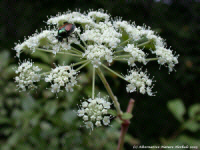Flowers for Craig Arnold. Flowers drifting down from the edge of the cliff where his footprints end. Tropical flowers and temperate flowers. Flowers. And stalks of angelica. And yet more flowers.

Beltane, otherwise known as May Day, is a festival of fertility that honors the sacredness of the earth and the male life-principle. This spring, Beltane fell right between Mother's Day and Earth Day. I marked the day (in addition to dancing around an imaginary maypole with my ten-year-old daughter) by reading at an event organized at the Portland planetarium by Jane Raeburn, poet, pagan, and the editor of The Pagan's Muse: Poems of Ritual, Inspiration and Invocation. Asked to choose images to project on the sky dome to accompany my poems, I chose nebulae, and flowers.
The Iranian poet Farideh Hasanzadeh asked once why, as a poet, I thought people offer flowers to the dead. The reply involved both analogy and sacrifice, metaphor and ritual.
At the reading, members of the community rendered their favorite classic poems interspersed with readings by poets. Under the big dome, planets and flowers revolved against the background of stars. Many of the poems centered on eros and spring, and we closed the night with an audience-interactive poem I had originally written for a Beltane ritual. Sharing our lives and our fragility and our poems in the tentative Maine spring, against the darkness, made me think again about Romanticism and lushness. And the fragility of the earth and of life.
The daring new third volume of Poems for the Millenium, edited by Jeffrey Robinson and Jerome Rothenberg, claims Romanticism as not a historical movement but rather a worldwide state of mind reaching from the eighteenth century into the present. It is a state of mind marked by decadence and passion, experiment and vulnerability. And maybe it will help put us in balance with our earth at last.
Reading Craig Arnold's extraordinary blog from the last month of his life, "The Volcano Pilgrim," I realize that the final experience documented there is eating the leaves of the angelica herb:
Afloat in my soup
sweetbitter leaves – a flavor
I’ve never tasted
"It seems like a fine thing to eat in spring," he writes, in a beautiful moment of grounded appreciation for the earth in this Beltane season. And then he proceeds to his final posting, "A Digression on Angelica":
Angelica is a member of the Apiaceae, the parsley or celery family, all of which have hollow stems and tiny flowers that present themselves in circular bunches or umbels. From this they get the fine title of umbellifer, umbrella-bearers. In the same family are anise, dill, chervil, celery, caraway, cilantro, cumin, carrot, fennel, parsnip, parsley and Queen Anne’s lace. Many of the umbellifers are delicious, some are contraceptive, and at least one, hemlock, is deadly poison, best known as the cup of hemlock that killed Socrates.
Angelica can grow immensely tall, nine or ten feet. In Northern Europe, the stalks are candied; in Iceland, they are eaten raw with butter; in Norway, the roots are made into bread. The herb has long held pride of place in folk medicine. In Earthly Paradise (1629), Parkinson extols the virtues of angelica to ease the stomach and “to expel any windy or noysome vapours.” It was also supposed to inspire disgust for alcohol – doubtfully, since it also provides one of the key flavors in gin, vermouth, Chartreuse and absinthe. Chinese Angelica, or dong quai, has recently been touted as a supplement for menopausal women. It seems also to speed the healing of ulcers, so Parkinson may have been on to something. The plant takes its name from the angel who is supposed to have revealed its medicinal properties to a dozing monk. Or from St. Michael the Archangel, around whose feast-day, May 8, it blooms.
In Japan the plant is called ashitaba, tomorrow leaf. They say it grows so quickly that leaves picked in the evening will be replaced the next morning. Or it may bring more tomorrows. During the Edo period, many of the Izu Islands served as penal colonies. Sent to investigate why the prisoners were stubbornly refusing to starve to death, officials found them subsisting quite healthily on wild angelica. The islanders still attribute their long lives to a diet of ashitaba. On Miyakejima you will see old ladies, impossibly old ladies, creaking their way home from the gardens, heads in kerchiefs, feet in two-toed tabi socks, dirt packed under their fingernails, their baskets filled with angelica, covered in white cloth.
Crushed in the hands, the fresh leaves are sweet, slightly musky – not quite mint, not quite juniper. It is a clean, windswept smell, the smell of meadow, of England, of green, the smell of a road after rain. It is the smell of a world in which there is nothing rotten or putrid or sulfurous, a world in which all of those things have been rinsed away.
Flowers for Craig Arnold. Flowers drifting down from the edge of the cliff where his footprints end. Tropical flowers and temperate flowers. Flowers. And stalks of angelica. And yet more flowers.
Annie Finch is a poet, translator, cultural critic, and performance artist. She is the author of seven...
Read Full Biography

